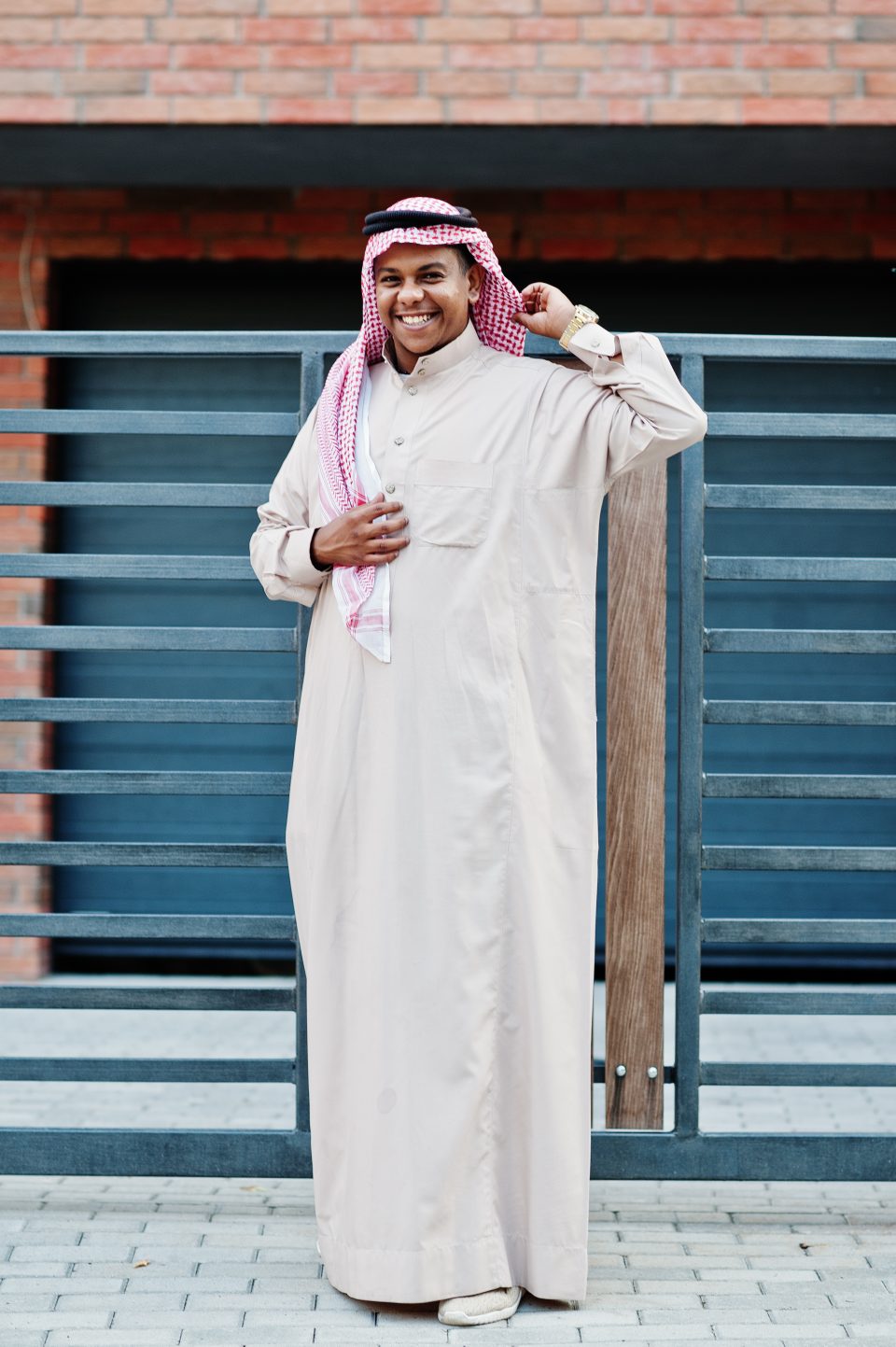When travelling through the Middle East or scrolling past a sharply dressed local on Instagram, you’ve probably spotted the long, flowing white robes known as the Dishdasha, Kandura, or Thobe. But are they the same thing? Well, yes and no. Think of them like espresso, long black, and macchiato: same core ingredient, different regional expressions.
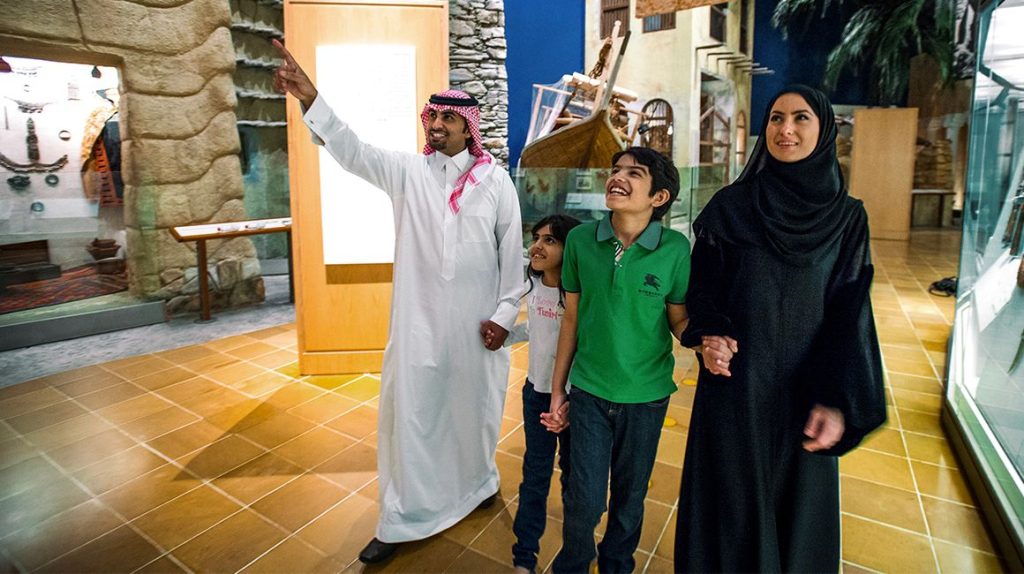
These traditional garments aren’t just a style choice—they carry deep cultural and religious significance. Rooted in Islamic modesty and shaped by centuries of climate and tradition, they’re a visible expression of identity and belonging in the Arab world. And today, they walk the line between timeless elegance and modern fashion.
In this article, we’ll break down:
- The origins of the Dishdasha, Kandura, and Thobe
- What each garment symbolises in its local context
- How they’re worn in traditional versus modern settings
- Tips for non-locals: when and how to wear them respectfully
- The legal implications of impersonating Emirati identity, especially on social media
Whether you’re a traveller, a fashion enthusiast, or just curious about Gulf culture, this guide will keep you informed (and out of trouble).
Origins and historical background of the Dishdasha, Kandura and Thobe
The Dishdasha, Kandura, and Thobe may look similar at first glance, but their histories are as layered as the cultures that wear them. These garments weren’t born on a runway; they were shaped by the desert sun, Islamic principles, and centuries of regional influence.
A garment born of climate and modesty
The roots of these robes trace back to the Arabian Peninsula, where loose-fitting garments helped people stay cool in blistering heat. The long length protected the legs from sunburn and wind-blown sand, while the breathable cotton or linen allowed air to circulate.
At the same time, Islam, which emerged in the 7th century, emphasised modesty in dress for both men and women. The long, robe-like garment quickly became a staple for its coverage, simplicity, and practicality.
Regional variations in name and style
Though similar in structure, the names and subtle styling differ depending on location:
- Kandura is commonly worn in the United Arab Emirates and Oman. It is usually collarless and typically bright white.
- Dishdasha is popular in Kuwait and parts of Iraq. It often has a more tailored fit and may appear in muted tones like grey or beige, especially in cooler seasons.
- Thobe (also spelled thawb) is found across Saudi Arabia, Qatar, and other Gulf countries. It may feature embroidery or detailing around the collar or chest.
These variations are not strict rules, but rather reflections of how local climate, culture, and identity have shaped the garment over time.
A timeless piece with practical roots
Despite centuries of social and technological change, the core design of these garments has remained largely intact. That is because they do their job well. Lightweight, modest, and comfortable, they offer a quiet but powerful expression of identity that has never needed to shout to be seen.
What the Dishdasha, Kandura and Thobe symbolise
To the untrained eye, these robes might just seem like functional clothing for hot weather. But for locals, the Dishdasha, Kandura and Thobe are far more than that — they carry meaning, status, and a deep connection to identity and faith.
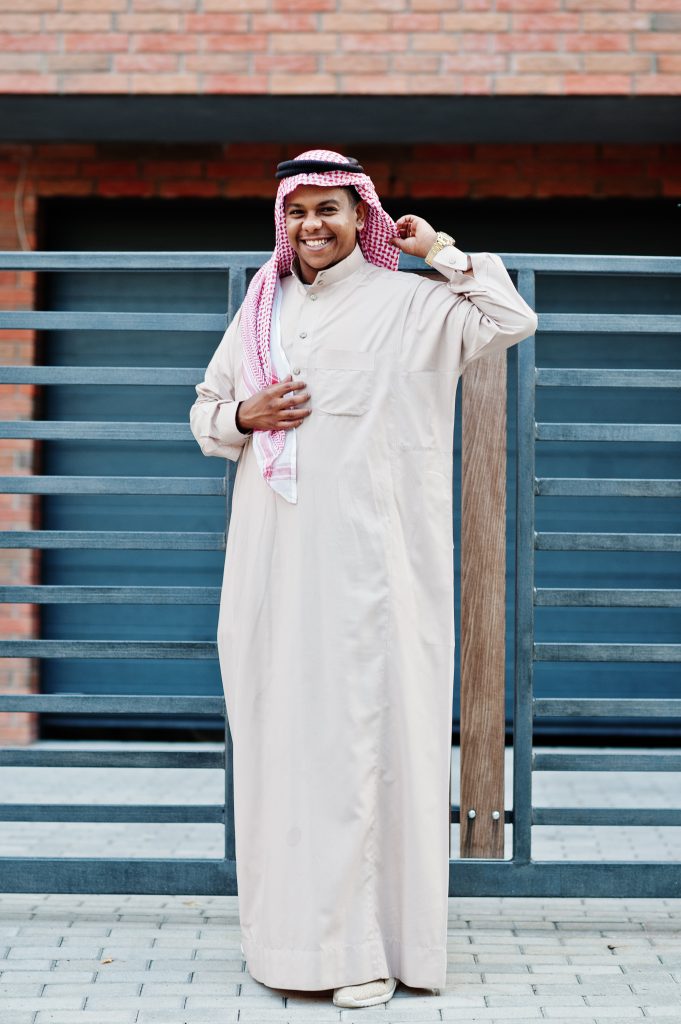
Cultural identity and belonging
These garments are often the most visible expression of national and cultural pride. In places like the UAE, Qatar, and Saudi Arabia, the way a man wears his robe can subtly signal where he’s from, his values, or even his tribe. The clean lines and modest design embody a quiet confidence — a statement of heritage that doesn’t need embellishment.
Wearing one also signifies a sense of belonging. Whether at a mosque, family gathering or government event, donning the national robe ties the individual to something larger — a shared cultural fabric that binds generations.
Religious symbolism
Islam promotes modesty, and these garments reflect that teaching. Their loose fit and full coverage align with Islamic principles of decency, humility, and simplicity in dress. For many, wearing the robe is both a cultural norm and a spiritual expression. It’s also a daily reminder to carry oneself with dignity and respect.
Modern-day status and prestige
While the basic design remains timeless, small details like fabric quality, tailoring, or accessories can reflect a man’s social standing. A crisp, perfectly fitted Kandura in bright white can signal wealth and attention to detail. In more affluent circles, it’s not uncommon to own dozens of robes, each custom-stitched and worn for specific occasions.
Some men pair the robe with designer sandals, luxury watches, and even branded sunglasses, bridging tradition with contemporary status symbols. The result? A powerful blend of heritage and modernity.
Traditional vs modern fashion pairings
The Dishdasha, Kandura and Thobe may look simple, but how they’re worn — and what they’re worn with — speaks volumes. Over the years, these garments have adapted from purely traditional dress to modern fashion statements, without ever losing their cultural roots.
Traditional pairings
Traditionally, these robes are worn with:
- Ghutra (headscarf): A square scarf, often white or red-and-white checkered, folded into a triangle and worn over the head.
- Agal: A black cord used to secure the ghutra in place.
- Undergarments: A lightweight cotton undershirt and trousers are typically worn underneath for modesty and comfort.
- Sandals or slippers: Open-toed leather sandals, typically black or brown, complete the look.
In formal or religious settings, the robe is expected to be pristine, well-ironed, and worn with traditional accessories. For Friday prayers, weddings, or national holidays, the ensemble is taken very seriously — immaculate presentation is a sign of self-respect and reverence.
Modern interpretations
Today’s younger generation, especially in the UAE and Saudi Arabia, have added a modern twist to how they wear the robe:
- Tailored fits: Slimmer cuts and shorter hemlines have become more common, particularly in urban centres like Dubai and Riyadh.
- Fabric choices: While cotton and linen dominate in summer, lightweight wool and synthetic blends are used for cooler seasons or indoor events.
- Luxury accessories: High-end watches, sunglasses, and even designer sandals are now common additions.
- Layering and colour: Some opt for layering with bishts (ceremonial cloaks) or experimenting with darker, seasonal tones like charcoal or navy in cooler months.
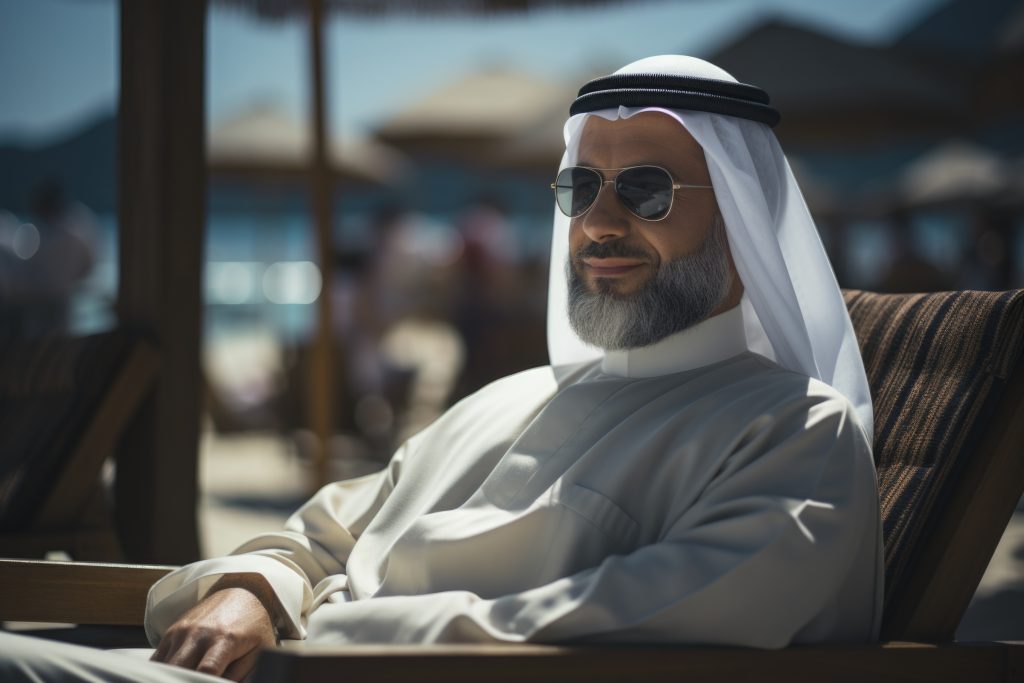
Despite the updates, the essence remains the same — elegance, modesty, and cultural pride. The modern man doesn’t see these garments as old-fashioned, but as a statement of timeless sophistication that can evolve with personal style.
How to wear It respectfully as a non-local
It’s one thing to admire the Dishdasha, Kandura or Thobe from afar. It’s another to wear one — especially if you’re not from the region. While locals are often welcoming and generous, there’s a fine line between cultural appreciation and disrespectful imitation.
When is it appropriate?
Wearing these garments as a non-local can be seen as a gesture of respect in the right setting. Appropriate situations might include:
- Weddings or cultural events where guests are encouraged to dress in traditional attire.
- Ramadan iftar invitations, where modesty is appreciated.
- Tourist experiences such as heritage village visits or cultural centre tours, especially when robes are provided as part of the experience.
If you’re unsure whether it’s suitable, the best approach is simple: ask. Locals will usually be happy to guide you.
What to avoid
Respectful intent isn’t enough if the execution is careless. Here’s what not to do:
- Don’t wear it as a costume or for amusement. This isn’t something to throw on for Instagram or a themed party.
- Don’t accessorise inaccurately, like pairing the robe with sneakers, baseball caps, or sunglasses indoors.
- Don’t use local dialects or mannerisms in an exaggerated or performative way. Imitating an accent or cultural gestures for laughs can easily cross into offensive territory.
- Don’t wear it during nightlife or when drinking alcohol. Associating the garment with behaviour that contradicts Islamic values can come across as deeply disrespectful.
Keep it modest and simple
If you’re invited to wear a robe, choose a clean, neutral style and wear it modestly. Avoid embellishments or fashion-forward takes unless you know they’re culturally accepted. Think of it like wearing a kilt to a Scottish wedding — elegant when done right, but awkward if you try to reinvent the wheel.
When in doubt, lead with humility. These garments carry centuries of meaning, and wearing them should always come from a place of cultural respect, not novelty.
Legal restrictions in the UAE: what non-locals need to know
In the United Arab Emirates, traditional dress is more than a cultural symbol — it is protected as an extension of national identity. That’s why wearing an Emirati Kandura or mimicking local dialects on social media is not just frowned upon, it can land non-locals in serious legal trouble.
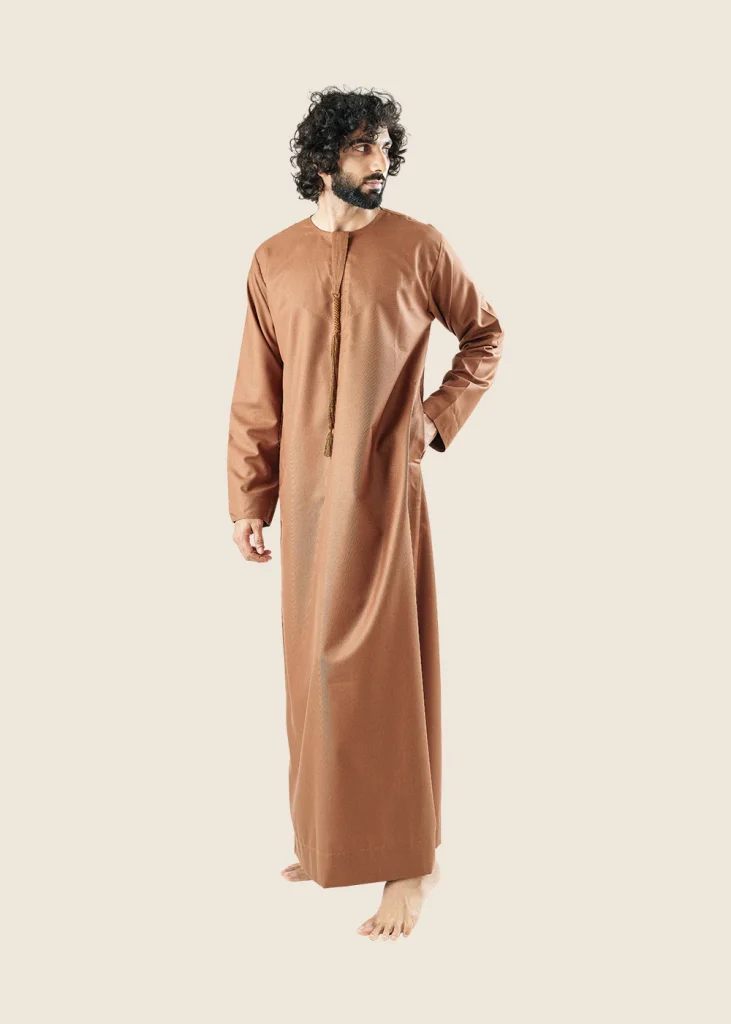
The law around traditional dressing
In 2023, UAE authorities issued firm warnings to non-Emiratis about wearing national garments, particularly when done for comedic or performative purposes on platforms like TikTok or Instagram. This came after a series of viral videos showed non-Emirati influencers dressed in Kanduras while impersonating the Emirati accent or behaviour.
The country’s Public Prosecution made it clear: this is not cultural homage. It is considered a violation of public decency, a misrepresentation of national identity, and in some cases, an act of insulting Emirati culture.
The potential consequences include:
- Hefty fines
- Detention or jail time
- Deportation for foreign nationals
Why the restrictions exist
The aim is not to alienate tourists or foreign residents. In fact, the UAE remains one of the most welcoming nations in the region and the world. However, these rules are in place to protect cultural dignity and discourage mockery or exploitation of the unique Emirati identity, especially in a digital world where things can spread fast and be taken out of context.
For Emiratis, the Kandura is not just a piece of clothing — it represents history, lineage, honour and nationhood. Treating it like a prop for clout undermines that meaning.
Bottom line for visitors
If you’re considering wearing traditional attire in the UAE:
- Only do so in respectful, approved contexts
- Avoid filming yourself in character or imitating locals
- When in doubt, ask a local or guide before dressing up
Appreciation is welcome. Performance and parody are not.
Tradition, identity, and knowing your place
The Dishdasha, Kandura and Thobe are more than garments. They are quiet declarations of identity, history, and values. Worn across the Gulf and the wider Arab world, they represent centuries of tradition and cultural pride, with every pleat and stitch tied to meaning.
For locals, these robes reflect modesty, spirituality, and social standing. For non-locals, they should be approached with care, admired, respected, and only worn when invited to do so. What might look like a simple piece of fabric is often loaded with unspoken codes that go far beyond fashion.
Modern styling may evolve, but the core remains unchanged: these garments are symbols of belonging. And belonging is never something you can fake, borrow, or perform. If you’re a visitor in the region, your best outfit is cultural curiosity paired with humility.
So yes, you can appreciate the elegance of a freshly pressed Kandura or the weight of a finely tailored Thobe. Just make sure your respect for the culture runs deeper than the fabric itself.

